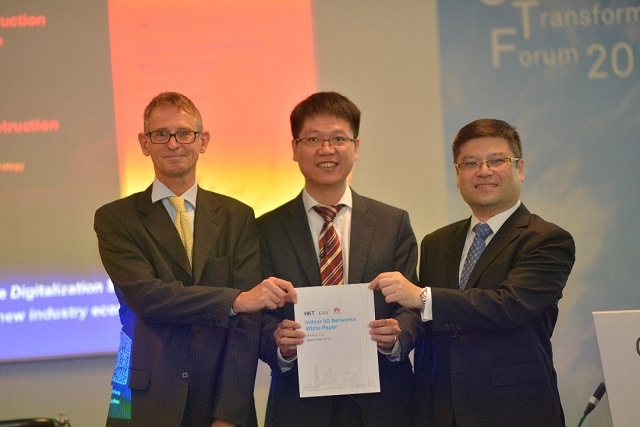HKT, GSA and Huawei Release Indoor 5G Networks White Paper
[Munich, Germany, September 4, 2018] Hong Kong Telco (HKT), Global mobile Suppliers Association (GSA), and Huawei have jointly issued Indoor 5G Networks White Paper which explains the complexity of indoor 5G network deployment. It discusses 5G indoor service network requirements, the evolution of existing network, and challenges in target network deployment, and recommends appropriate construction strategies.

Danny Dicks, Research Consultant at GSA(left), Simon Liang, General Manager of Huawei's Indoor Coverage Digitalization Domain(middle), Sheldon Yau, Senior Vice President of HKT Wireless Network Planning & Design(right) jointly issued Indoor 5G Networks White Paper.
The white paper points out that more than 80% of service usage on 4G mobile networks occurs indoors. The industry predicts that a greater number of mobile services will take place indoors as 5G spurs service diversity and extends business boundaries. As a result, says the white paper, indoor mobile networks in the 5G era will become essential to operators' competitiveness.
Danny Dicks, Research Consultant at GSA, said: "Various services such as virtual reality (VR) and telemedicine will flourish in the 5G era. Indoor 5G digital networks will be essential to help ensure optimal user experience, efficient operation and maintenance (O&M), and intelligent operation. The industry urgently requires further research into the network requirements of indoor 5G services and network deployment strategies".
The white paper discusses key requirements and performance indicators for indoor 5G target networks based on the features of the three major types of 5G services (enhanced mobile broadband, ultra-reliable low-latency communication and massive machine-type communication). The specific requirements of augmented reality (AR), VR, high-definition (HD) video, telemedicine, and smart manufacturing are elaborated.
Using test data and theoretical analysis, the white paper analyzes the challenges facing indoor 5G target network deployment. These include coverage, capacity expansion, reliability, O&M and operation. It then describes a series of deployment strategies in terms of architecture, Multiple-Input Multiple-output (MIMO), solution selection, capacity planning, network reliability, network O&M, and operation. These strategies provide guidance for indoor 5G network deployment, including:
- Capacity: Build elastic capacity to flexibly meet service requirements.
- Reliability: Use coverage, capacity and topological redundancy.
- Deployment: Use E2E digital deployment to lay a foundation for network O&M.
- Network O&M: Visualize network status for manageable and controllable indoor 5G networks.
- Network operation: Make operation of indoor 5G networks intelligent by using a network operation platform between network and application layers.
Sheldon Yau, Senior Vice President of HKT Wireless Network Planning & Design, said: "Traditional passive indoor distributed systems cannot meet the requirements and challenges of indoor network upgrade and evolution in the 5G era. Only the innovative digital all-optical architecture can carry multiple systems and services to support more innovative services, faster data rates, flexible network expansion, efficient E2E operation, and smooth 5G evolution. This way, operators can effectively cope with the growing service types and service experience requirements in the 5G era".
The white paper recommends indoor digital distributed base stations of 4T4R or above, with E2E digital integration. Dense, high-capacity networks with flexible capacity adjustment, and visualized O&M are also advised, and the white paper also proposes that intelligent operation of indoor 5G networks should be based on a network operation platform.
Liang Shiming, General Manager of Huawei's Indoor Coverage Digitalization Domain remarked: "In the 5G era, indoor networks will be crucial to high-value mobile networks. Indoor coverage digitalization is the inevitable future of the industry. Huawei has proven capabilities and considerable experience in indoor network consulting, scenario-based solutions, digital products and integration, and industrial ecosystems. These put Huawei at the forefront of the indoor digital industry. In the next five years, Huawei will further increase its investment in the business solution development of indoor digital coverage. The company will also step up its cooperation with operators and industrial partners. The aim is to work with all parties to develop brand-new business models and industrial ecosystems, and usher in an era of 5G indoor digital coverage".
To download the white paper, please visit: PDF, 5MB

